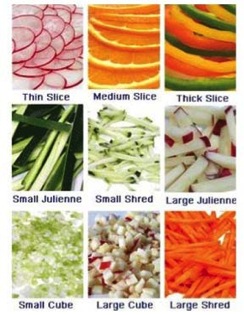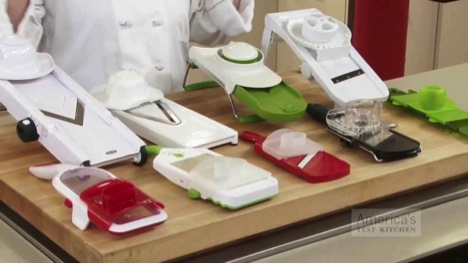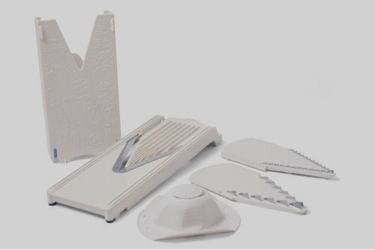Get Past the Mandoline Intimidation and Save a TON of Kitchen Prep Time!
The advice from nutritionists, doctors, and weight-loss experts is the same: include more fresh fruits and vegetables in your diet. I understand the advice, but have to admit I get very tired of all the prep work that goes into using fresh produce.

If you can relate, then let’s take a look at a fresh fruit and veggie tool that makes the slicing, dicing, shaving, julienning, and etc., easy easy easy. I’m talking the mandoline.

A good mandoline can thin-slice and julienne produce far faster than a skilled cook wielding a sharp knife, and with utter precision—the results are always uniform. That uniformity is at least as valuable as the time savings—and not just for cosmetic reasons. When cuts are uneven, so is cooking.
But while a mandoline can be the handiest tool for prepping fruits and vegetables, it can be intimidating to use. That said, let’s get past the intimidation by learning all about it, especially how to use it. Here I’m passing on the research I gleaned from several websites (Food Network, Chowhound, America’s Test Kitchen, Gadgets for the Kitchen, Consumer Research, and the Garden Web):

First, all about mandolines in general and what’s the best choice: All the pros agreed that for a mandoline to be consistently used, it must be easy to set up, clean, and store.
While most mandolines operate similarly, you hold the food with a hand guard and push it along the surface to the blade (adjusting slice thickness by changing the distance between the platform and the blade), there was one main issue that made the operating of them dicey (pardon the pun)—safety.
And America’s Test Kitchen experts were fanatical about a mandoline needing to be as safe to use as it is efficient. The testers didn’t feel all that safe with most models. Typical paddle slicers, for instance, made folks nervous because the hand guards weren’t effective. Then there was the issue of swapping out blades—an accident waiting to happen. Hands came dangerously close to sharp edges—you just don’t want a model that jerks all over the place when you’re trying to snap the right blade onto the platform.
The folks on the sites I studied also agreed on another thing—they weren’t impressed with those that required fussy setups and maintenance or that came with blades for making every conceivable cut (a level of operation that most home cooks just won’t use).

OK then, after testing 9 different mandolines, which one did the testers give the most votes to? The Swissmar Börner Original V-Slicer Plus Mandoline . Here's why:
· Hands were kept away from blades when using. It was extremely safe to use.
· It was effortless to push food through its razor-sharp blades, and every piece of produce that was sliced or julienned emerged with stunning, diamond-cut edges.
· It has a long, unobstructed platform, which enabled testers to produce long, graceful zucchini planks and full-length French fries. Testers never had to pre-trim foods, so waste was minimal.
· Finally, a unique perk: It has a caddy that stands vertically, which limits the mandoline’s footprint to inches. That setup is a boon to cleanup and safety, too. After washing, you can simply load the parts into the caddy to air-dry (where sharp edges are covered), and then hang the hand guard on its hooks like a hat.
One thing, though: This tool retails for around $40. You’ll find it for a few dollars less on amazon.com, but still…that’s a chunk of money. So the only way purchasing this could be justified is by using it consistently every week. So for that, here are the tips:
For making the most out of this versatile tool:
· Safety first, always! Don't even think about slicing anything without the hand guard—it’s not worth the risk.
· Use the right blade for the job. Most mandolines come with three or four slicing blades beyond the basic blade. These allow you to slice paper thin (think potato chips), a little thicker, thick julienne (think french fries), and thin julienne. If you're not sure how your blades will slice, invest in a few potatoes and try each setting out. (To get the hang of the process, it’s a good idea to experiment on extra veggies until you learn how to use your mandoline.)
It’s true that a very sharp chef’s knife can also slice, dice, and julienne. But if you’re wanting a more precise product in less time, the mandoline is the way to go. And since MORE is the word when it comes to fruits and veggies, the mandoline is probably the answer to that issue as well (if we can get past the intimidation)!
- www.simplygoodstuff.com
- www.americastestkitchen.com
- www.amazon.com
 Alice Osborne
Alice Osborne
Weekly Newsletter Contributor since 2006
Email the author! alice@dvo.com
